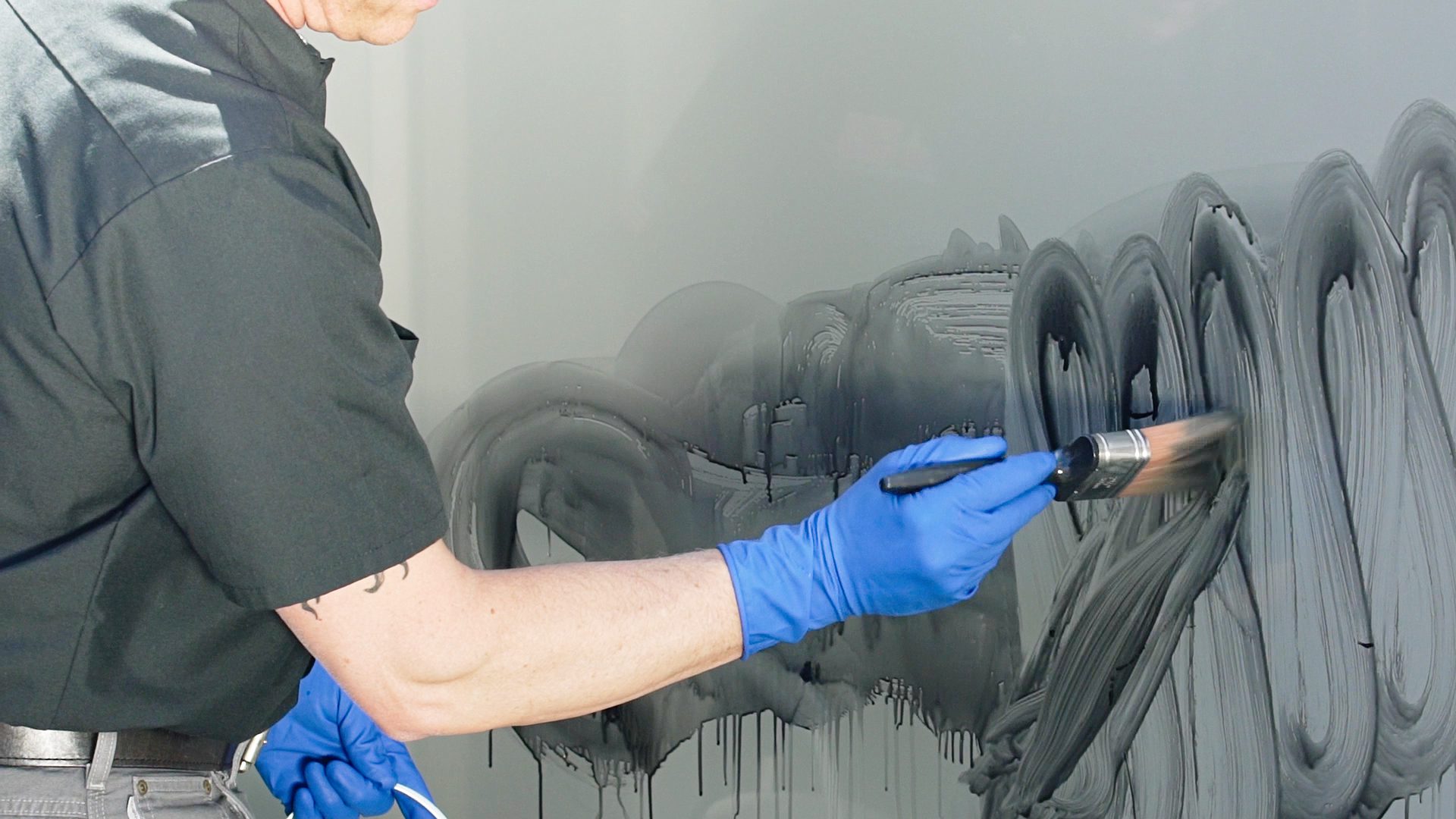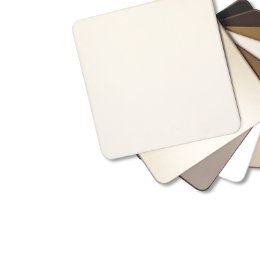Quick, Safe Graffiti Resistance & Removal

Whatever you may think about the talents of someone like Banksy, graffiti is not art. It’s a crime. And while a Banksy tag may bring an unexpected windfall for the property owner, for the rest of us graffiti is nothing but an ugly and expensive nuisance.
The city of Los Angeles cleans up more than 30 million square feet of graffiti every year at a cost of around $7 million. In the U.S. alone, various estimates of the yearly costs of graffiti repair range from about $12 billion to as much as $20 billion – more than the annual budget for NASA, about four times the cost of auto theft and about 20 times the budget for the National Endowment for the Arts. And that doesn’t include the costs of devalued properties, threatened communities and damaged lives.
Those costs are incalculable. But the cleanup costs are very real to the building owner who has to deal with the problem. That’s why we asked Sherwin-Williams, our finish partner for ALPOLIC® materials, to help us come up with a quick, easy and affordable method for graffiti removal.
Mark MacDonald, sales and marketing manager at Sherwin-Williams, found the answer in an unexpected way.
While researching the problem, MacDonald asked his friend Paul Watts, owner of Watts Removal, if he could ride along and watch as Watts cleaned up graffiti at various locations around Portland, Oregon. “The first thing Paul did was to tag my car with spray paint and Sharpies,” MacDonald recalls. “He said, let’s give it some time to cure a bit while we drive around town and do some graffiti removal.”
Watching his friend vandalize his car was shocking enough. But MacDonald was even more shocked at how easily Watts was able to remove all kinds of graffiti without painting over or damaging the underlying surface, without handling caustic chemicals or wearing a respirator, and without having to clean up a toxic mess afterward. Watts even had MacDonald help out to see how quick and easy it was. At the end of the ride-along, MacDonald helped remove the tags from his car in a matter of seconds.
Watts’s secret is a remarkable product developed by a partner expressly for the purpose of removing graffiti.
Traditional graffiti removal methods involve:
• Painting over the graffiti, which creates a patchwork effect, often peels over time, and makes future graffiti removal even more challenging
• Stripping the graffiti with hazardous chemicals such as modified paint strippers or brake fluid that can damage the original finish and the surrounding environment
• Mechanical methods such as sandblasting or wire brushes that abrade the underlying surface
• A combination of these labor-intensive, damaging and unhealthy methods
The product used by Watts Removal for the bulk of its removal projects has none of these drawbacks.
Watts describes it as a mix of “soluble oils and alcohol that actually encapsulate and penetrate into the graffiti itself to dissolve it, without damage to the substrate.” The product goes to work immediately, essentially “floating” the graffiti off the surface so it can be wiped away with a damp towel.
Jobs that might take many hours and thousands of dollars to complete using traditional methods – with less than satisfactory results – can be finished beautifully in minutes, without damage to the original surface.
Watts says, “The system is built on being very fast. When you want graffiti gone, you want it gone now. With most products, there’s a dwell time of 45 minutes to an hour where you have to let the product sit on the graffiti before you can even try to remove it. But this is instantaneous. Once our product touches the graffiti, it starts to dissolve.” And it’s safe to use, requiring no special precautions or cleanup methods.
If it all sounds too good to be true, that was our first reaction too.
The industry-standard method for fighting graffiti on painted composite materials is to apply a special coating on top of the standard finish that is designed to resist or be sacrificed to the harsh chemicals normally used to remove graffiti. This extra coating can be costly, especially in smaller runs of material, and building owners are still left with the time, effort and hazards of using modified paint strippers every time the building is tagged. If the coating is sacrificial, subsequent graffiti attacks may not be removable at all without causing significant finish damage.
The Watts Removal method and ALPOLIC Sherwin-Williams finish materials’ works with no special coatings required.
That’s great, because we want to save our customers time and money whenever we can, and we want to protect the long-term beauty of our products. But before we gave it our stamp of approval, we needed to make sure the Watts Removal method would work with our Sherwin-Williams finishes reliably, without damaging the original finish...so we tested the Watts Removal system alongside many other graffiti removal products, using ASTM standard testing protocol.
In fact, we went well beyond the ASTM method by baking graffiti-covered panels in an oven, leaving the tested cleaning products on the surface for 1,000 hours, and exposing the restored surface to UV-B radiation for 1,000 hours to simulate aging. “We do not want people to have the [Sherwin-Williams] finishes on their ALPOLIC materials damaged at all,” says Mark MacDonald, “even if the damage isn’t evident until it has been exposed to the elements for many years.”
Only the Watts Removal method passed these demanding tests. All the other products we tested either damaged the original paint or wouldn’t completely remove the most difficult types of graffiti – such as tags written in a Sharpie pen. The combination of Sherwin-Williams finishes and Watts Removal products delivered unbelievable results, with minimal cost and effort.
In collaboration with Sherwin-Williams and Watts Removal, we are now able to offer a graffiti removal solution that doesn’t require the expense of special coating, works in minutes rather than hours or days, and keeps your building looking beautiful for decades – just as you intended when you specified ALPOLIC Sherwin-Williams finish materials.
It’s available as a brush-on, wipe-off product that works in minutes and requires virtually no cleanup. It’s even available in hermetically sealed “wipes” that are easy for maintenance personnel to carry every day for small clean-up projects.
Because no special coating is required, the graffiti-removal system even works with existing ALPOLIC Sherwin-Williams finish panels already installed in the field.
Bill Yannetti, director of operations for ALPOLIC Materials, explains, “We were graffiti-resistant before we even knew we were. If a building spec says it has to be graffiti-resistant, you can satisfy the spec by using a toxic system that requires a special top coat, or you can use our benign system that doesn’t. It’s environmentally friendly, requires no extra cost, and isn’t a custom product.”
Yannetti cautions that we can’t warrant the finish surface directly under the graffiti tag, because we don’t know what chemicals the so-called “artist” used to vandalize your building. But we can assure you that our graffiti-removal solution will get rid of almost any tag in minutes, with no additional damage to your new or existing finish.
In a world that spends many billions of dollars fighting graffiti, our system can save you a lot of money while helping keep the world beautiful.
Even Banksy has said, with regard to an exhibition of his “artworks” salvaged from buildings and offered for auction, “I think it’s disgusting people are allowed to go displaying art on walls without getting permission.” Presumably, he was speaking with tongue in cheek, but he’s right. And since graffiti “artists” almost never ask for permission in advance, it’s up to municipalities and building owners to deny them permission after the fact.
The best defense against graffiti is prompt approval. We’re proud to be joining with Sherwin-Williams and Watts Removal to make graffiti removal as quick, easy and inexpensive as possible. Because vandalism should never get in the way of the authentic art that is the realization of your architect’s vision.
Visit our graffiti resistance page to learn more and watch a video demonstrating how easy graffiti removal can be, thanks to Sherwin-Williams, Watts Removal and ALPOLIC Materials.






